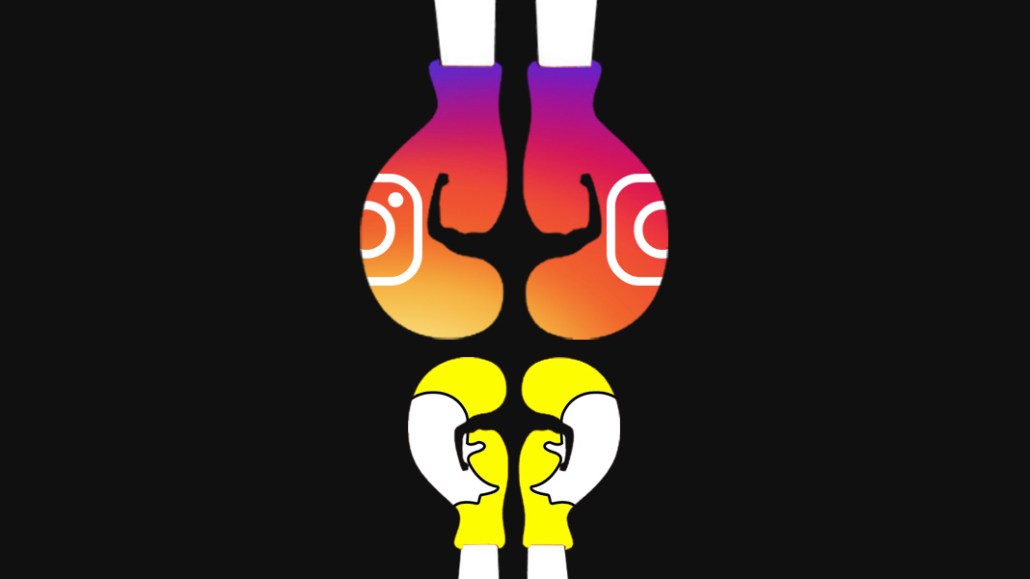Best of the week: Snapchat is losing the fight against Instagram, for now

This week, our top stories focused on new metrics problems for Facebook and the battle between Snapchat and Instagram for users and ad dollars. Enjoy a dose of the platform drama this holiday weekend with what many are calling the drink of the summer, the Aperol spritz (which we have details on, too). As always, a full list of these articles appears at the bottom.
Facebook’s metrics woes continue
After admitting to a string of measurement errors over the past year, Facebook has bowed to pressure from ad buyers and started letting third-party auditors check its numbers.
The results: Some agencies have seen viewability rates on Facebook video campaigns as low as 20 percent, according to interviews with nine media agency execs. That’s way below the average viewability rate for video ads on sites, which is about 50 percent, per Integral Ad Science. Execs are concerned, with some saying they would revisit their budgets for branding campaigns.
“This is a big issue,” said one exec. “It’s money being taken off advertisers that they’re not getting their fair whack on.”
Brands and publishers favor Instagram over Snapchat
It’s not all bad news for Facebook. It continues to improve Instagram’s Snapchat-like features, which seems to be paying off.
The numbers:
- 200 million: The number of daily Instagram Stories users, which has surpassed Snapchat’s 166 million daily users.
- Snapchat’s growth has slowed 82 percent since Instagram Stories launched in August.
- Snapchat made $1.05 per user in the last quarter of 2016, compared to Facebook’s $7.16 per user during that period.
At Cannes Lions, Snap execs urged advertisers to focus on Snapchat’s creativity and functionality rather than user numbers.
But how much Snapchat can scale remains a question. That, plus its rudimentary analytics and less intuitive user experience have led fashion brands to reduce or stop their Snapchat usage. Publishers such as Attn are devoting more resources to Instagram for the same reasons.
Publishers also find Instagram more appealing because it offers more monetization opportunities than Snapchat, which bars users from doing branded content and keeps a tight grip on which publishers join its Discover section, where publishers can monetize content through ads Snapchat sells itself.
And since Instagram raised the maximum length on a video to one minute 15 months ago, publishers started focusing on video there, according to NewsWhip. This has helped them broaden reach and drive traffic, revenue and engagement on and off Instagram.
Audience growth and Instagram Stories have prompted BBC News to prioritize Instagram over Snapchat. BBC News’ Instagram Stories get an average of 100,000 views, said Mark Frankel, the publisher’s social media editor. BBC News incorporated Snapchat in its Brexit coverage, but didn’t use it to cover the U.K. general election.
“It’s not worth having a dedicated team of staff on a [Snapchat account] that has just 3,000 on for us,” said Frankel, but he added that could change in the future.
One Snapchat investor in the process of selling his stock has a grimmer assessment of the platform: “It’s dead.”
Interesting takes elsewhere:
- SportsBusiness Journal’s John Ourand examines the state of ESPN.
- Jeff Gerth reports on the increasingly blurry divide between journalism and advertising at The New York Times for the Columbia Journalism Review.
- Business Insider’s Richard Feloni delves into Unilever’s use of artificial intelligence for hiring.
This week’s top Digiday stories:
- How Instagram-friendly Aperol spritz became the drink of the summer
- Facebook video ad viewability rates are as low as 20 percent, agencies say
- Snapchat falls farther behind Instagram with fashion brands
- Snapchat’s Cannes pitch: Bigger isn’t better
- How news publisher Attn is getting Instagram to pay off
- Instagram video is soaring for publishers
- BBC News is betting on Instagram Stories over Snapchat
- How Salon regrouped after Facebook decimated its traffic
- Cheatsheet: The state of paying for news
More in Media

Publishers are hunting for AI prompt data — now they’re starting to get it from third-party companies
Publishers are finally gaining some visibility into AI search, as new prompt data tools crack open a black box.

Digiday+ Research: Publishers’ growing focus on video doesn’t translate to social platforms
Major publishers have made recent investments in vertical video, but that shift is not carrying over to social media platforms.

Technology x humanity: A conversation with Dayforce’s Amy Capellanti-Wolf
Capellanti-Wolf shared insight on everything from navigating AI adoption and combating burnout to rethinking talent strategies.







